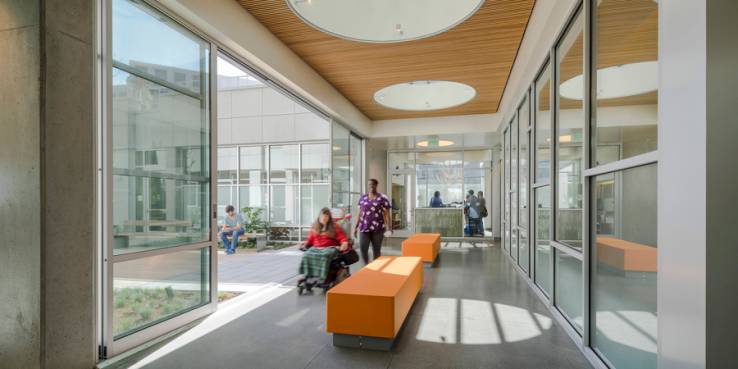Voters in cities and counties around the Bay Area have recently proven their commitment to addressing homelessness issues by passing generous funding measures. While the number of homeless residents in the region may not be radically increasing, homelessness has become a more visible and pressing issue for individuals, businesses, organizations and public agencies.
However, resistance to housing proposals that would actually serve homeless residents remains strong. Earlier this year, Mission Bay homeowners turned out to oppose a long-planned housing development for the formerly homeless — in spite of the existence of successful similar developments not far away. A proposal for affordable senior housing in Forest Hill faces opposition from nearby residents who fear the 20 percent set-aside for formerly homeless households. In August, the San Jose City Council faced strong opposition to a proposal to build tiny temporary homes on sites in every district across the city. In order to successfully approve, create and provide these homes, the Bay Area will need strong political will and public support. How do we get that public support? In party, by demonstrating that providing homes to people in need benefits everyone.
One key approach to serving homeless residents who need the most support is permanent supportive housing, which puts counselors and other voluntary social services right in the building. Residents are not expected to move on eventually — their apartment is their permanent home. Successful models already exist around the Bay Area, and there are more in the pipeline, including SF’s Mission Bay Block 9, 1068 Mission, 180 Jones, Berkeley’s Berkeley Way homeless housing project and PATH San Jose. Supportive housing is a nationally recognized best practice that we will see more of in the future — as long as these developments can get approved. San Francisco’s Department of Homelessness and Supportive Housing alone has approximately 7,400 supportive housing units in its portfolio; it isn’t enough, but it’s a great start. That’s an estimated 8,500 to 9,000 people who are living in homes and not on the street.
Here are three reasons why supportive housing should matter to all of us:
1. Supportive Housing Serves Real Needs
Supportive housing is set up for people with special needs, sometimes those who are formerly homeless, sometimes those with disabilities. Supportive services are tailored to the needs of the individual and might include case management, mental health services, job training, alcohol and drug abuse programs, and other social services.
Supportive housing in the Bay Area is typically built and managed by nonprofit organizations, and services may be provided by both public agencies and nonprofits. Heavy involvement from the city and the county is also typical, as these developments usually require operating and services assistance as well as capital funds for construction or renovation.
Supportive housing does not always take the form of a newly constructed building specifically intended to serve people with special needs. In fact, of the more than 7,000 supportive housing units in the city’s portfolio, the majority are in older buildings. Individuals may be placed in existing buildings with rent subsidies and visiting or offsite services, or it may take the form of units set aside within an affordable housing development for the general population. In San Francisco many supportive housing developments are older apartment buildings that have been acquired and retrofitted to serve the needs of formerly homeless residents.
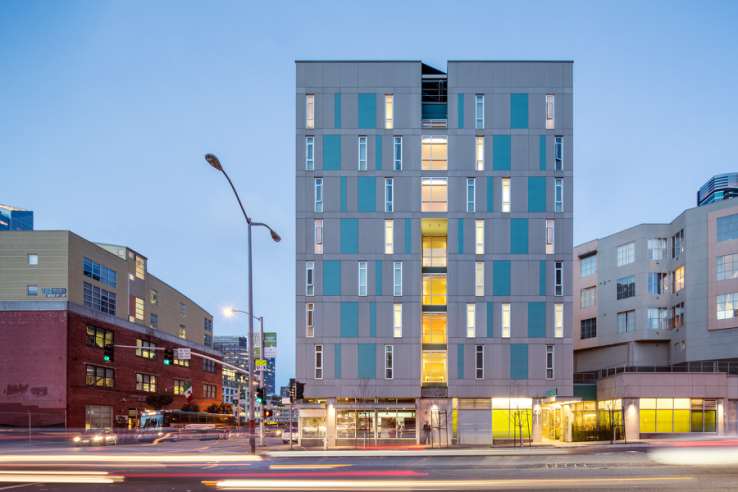 Rene Cazenave Apartments, developed by Community Housing Partnership and BRIDGE Housing Corporation, includes 120 homes for the formerly homeless as part of the Transbay neighborhood. Image by Tim Griffith, courtesy of LMSA.
Rene Cazenave Apartments, developed by Community Housing Partnership and BRIDGE Housing Corporation, includes 120 homes for the formerly homeless as part of the Transbay neighborhood. Image by Tim Griffith, courtesy of LMSA.
However, San Francisco does have several standout examples of new supportive housing. Richardson Apartments in Hayes Valley and Rene Cazenave Apartments at the base of Rincon Hill each include 120 units (studios and one-bedrooms) and comprehensive onsite supportive services. These two developments have generous communal gathering places, both indoors and outdoors. Both were planned with roof gardens for residents to tend. The units are small but efficient and designed for livability.
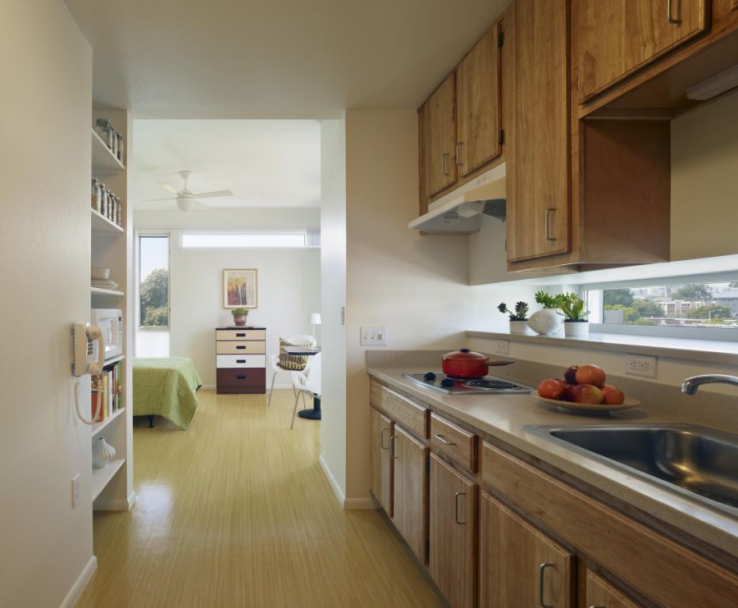 Supportive housing units at Richardson Apartments in Hayes Valley are compact and efficient but functional and livable. Image by Bruce Damonte, courtesy of David Baker Architects.
Supportive housing units at Richardson Apartments in Hayes Valley are compact and efficient but functional and livable. Image by Bruce Damonte, courtesy of David Baker Architects.
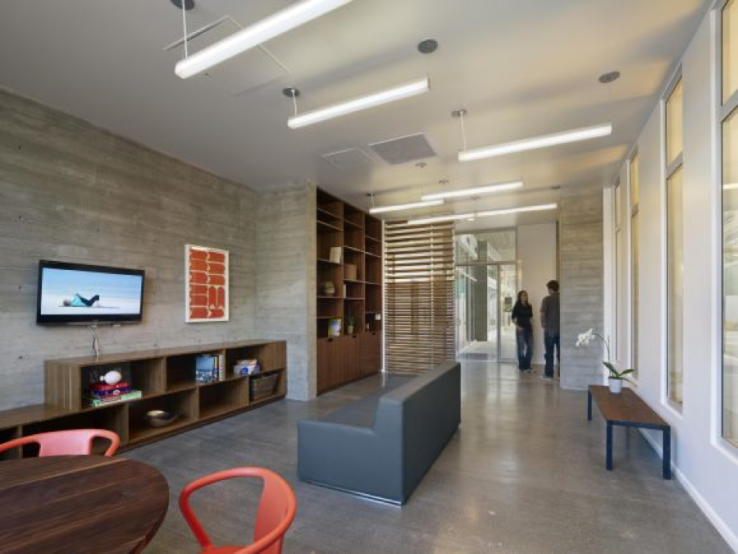 A common area lounge at Richardson Apartments is open to residents for impromptu gatherings and relaxing. Image by Bruce Damonte, courtesy of David Baker Architects.
A common area lounge at Richardson Apartments is open to residents for impromptu gatherings and relaxing. Image by Bruce Damonte, courtesy of David Baker Architects.Common areas are designed to work for planned gatherings and activities as well as informal relaxing and conversation. Since residents must voluntarily choose to access services, the services suites are located in inviting locations within the building, close to main hallways and congregating areas where it’s easy for social workers to say hello and easy for residents to drop in.
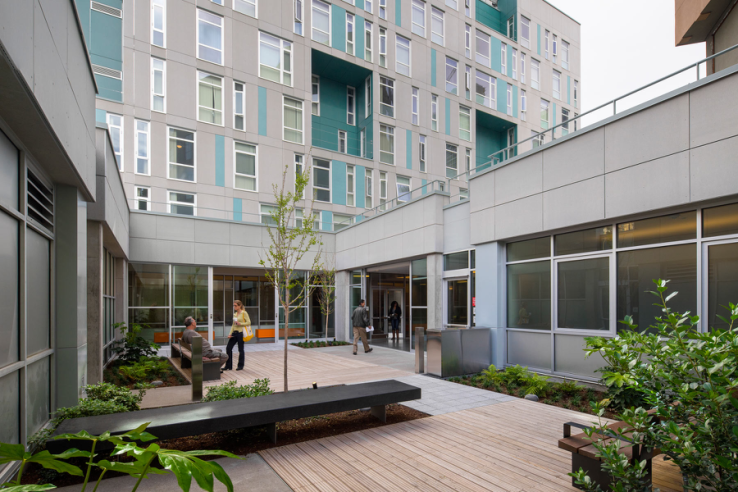 An enclosed courtyard at Rene Cazenave Apartments gives residents the opportunity to spend time outside away from street traffic. Image by Tim Griffith, courtesy of LMSA
An enclosed courtyard at Rene Cazenave Apartments gives residents the opportunity to spend time outside away from street traffic. Image by Tim Griffith, courtesy of LMSA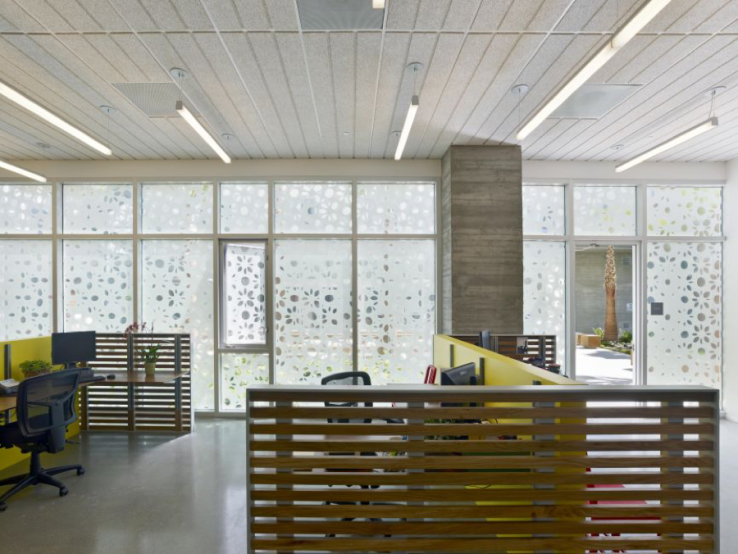 The supportive services suite at Richardson Apartments is located adjacent to the building entry reception and courtyard, making it easy for residents to access services. Image by Bruce Damonte, courtesy of David Baker Architects.
The supportive services suite at Richardson Apartments is located adjacent to the building entry reception and courtyard, making it easy for residents to access services. Image by Bruce Damonte, courtesy of David Baker Architects.
Supportive housing is intended to treat residents like whole people who deserve a decent quality of life and access to the services that they need.
2. Supportive Housing Is Cost-Effective
Supportive housing is not appropriate for all who experience being homeless. It’s not for the family that is just one paycheck away from stability, or for the young adult who has recently exited the foster care system and simply needs some help finding housing and accessing the tools needed to navigate adulthood. Why? Supportive housing is not inexpensive. The individualized services, the special facilities onsite and the appropriate staffing all come with costs. It’s important to have a housing “ladder” that enables residents who no longer need the deep services of supportive housing to move into below-market rate homes without services when they are ready. But if supportive housing developments house residents who truly need these deep services they can be extremely cost-effective.
Two years ago, Destination: Home in Santa Clara County commissioned a complex study to look at the full costs of serving the county’s homeless residents. The study found that the county was spending $520 million a year serving homeless residents, 87 percent of it through the health care and criminal justice systems. Further, the top five percent of individuals incurred 47 percent of the total costs, averaging out to $100,000 a year per person. The top 10 percent incurred 61 percent of the total, averaging out to $67,000 a year per person. These per-person annual costs far exceed the typical cost to house and provide services for people experiencing homelessness. On the basis of cost alone, supportive housing looks like a good deal, but of course, cost-effectiveness isn’t the full picture.
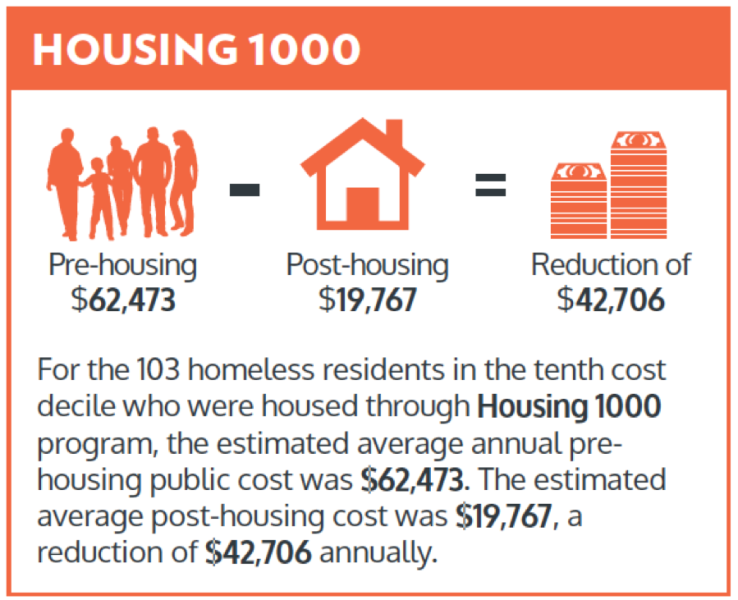 The analysis in Home Not Found documented that it makes clear financial sense to house and provide services to the most needy residents in the community. Image courtesy of Destination: Home.
The analysis in Home Not Found documented that it makes clear financial sense to house and provide services to the most needy residents in the community. Image courtesy of Destination: Home.3. Supportive Housing Benefits the Broader Community
Richardson Apartments and Rene Cazenave Apartments exemplify how supportive housing not only serves its own residents but provides benefits to neighbors and the broader city. These buildings help people to get off the street and are also good neighbors themselves.
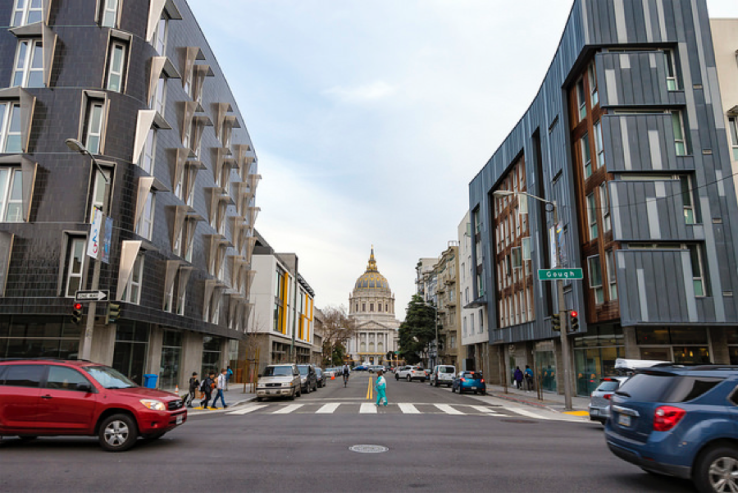 The market-rate microunit condominiums at 388 Fulton (left) and Richardson Apartments, a 120-unit supportive housing development for the formerly homeless (right), were both designed by David Baker Architects. Image by Sergio Ruiz for SPUR.
The market-rate microunit condominiums at 388 Fulton (left) and Richardson Apartments, a 120-unit supportive housing development for the formerly homeless (right), were both designed by David Baker Architects. Image by Sergio Ruiz for SPUR.The buildings are attractive, designed with attention with regard to functionality as well as beauty. It’s hard to tell the difference between Richardson Apartments and 388 Fulton, a market-rate condominium development across the street designed by the same architect.
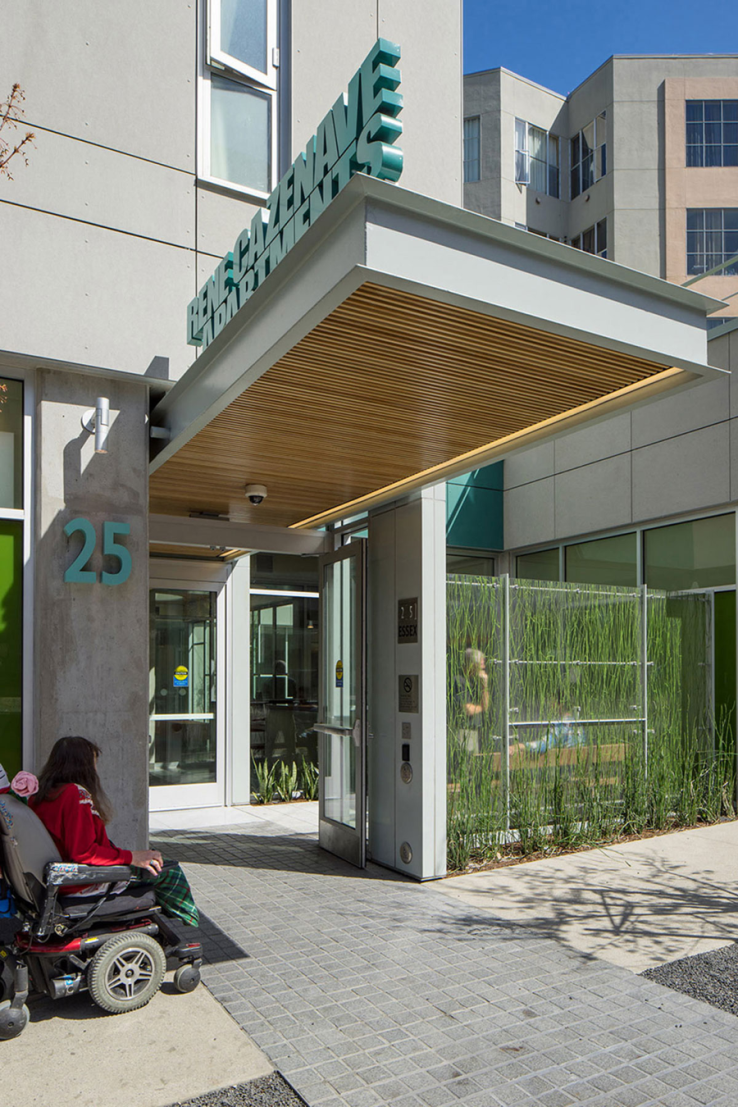 The entry at Rene Cazenave Apartments includes space for residents to socialize or spend time outside without impeding pedestrians on the sidewalk. Image by Tim Griffith, courtesy of LMSA.
The entry at Rene Cazenave Apartments includes space for residents to socialize or spend time outside without impeding pedestrians on the sidewalk. Image by Tim Griffith, courtesy of LMSA.Both buildings encourage positive activities in the public realm. Instead of blank walls, they provide active ground floors with community-serving uses, like cafes, eateries and small-scale retail. They attract neighboring residents and workers, keeping eyes on the street during the day and evening.
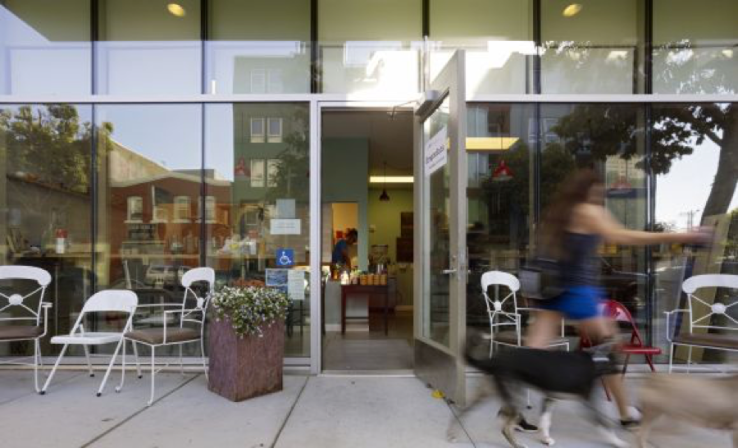 Restaurants and retail on the ground floor of Richardson Apartments serve the neighborhood and encourage sidewalk activity. Image by Matthew Millman, courtesy of David Baker Architects.
Restaurants and retail on the ground floor of Richardson Apartments serve the neighborhood and encourage sidewalk activity. Image by Matthew Millman, courtesy of David Baker Architects.Lastly, the nonprofits that manage these developments are accustomed to working with all kinds of people and take pride in ensuring that the buildings are well-kept and in helping their residents be good neighbors.
Supportive housing is not the only tool in the toolkit to combat homelessness. Rent subsidies, temporary housing and other types of assistance are more appropriate and effective for some. But creating more supportive housing throughout the Bay Area will help provide homes and support to many of those who have ended up in the hardest of circumstances. The investments we make in supportive housing will pay off in many ways, both for these residents and for their neighbors.
See news coverage of the Bay Area’s homelessness issues >>
Learn about SF’s Department of Homelessness and Supportive Housing >>
